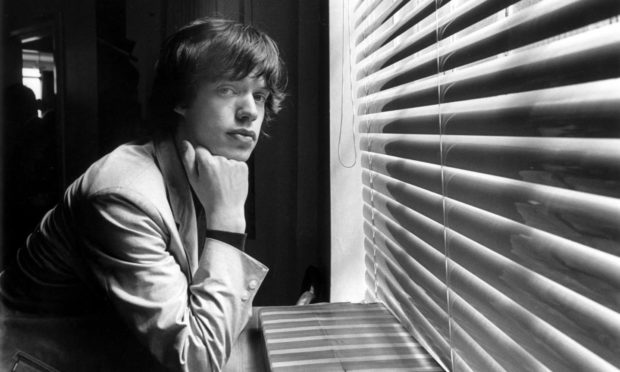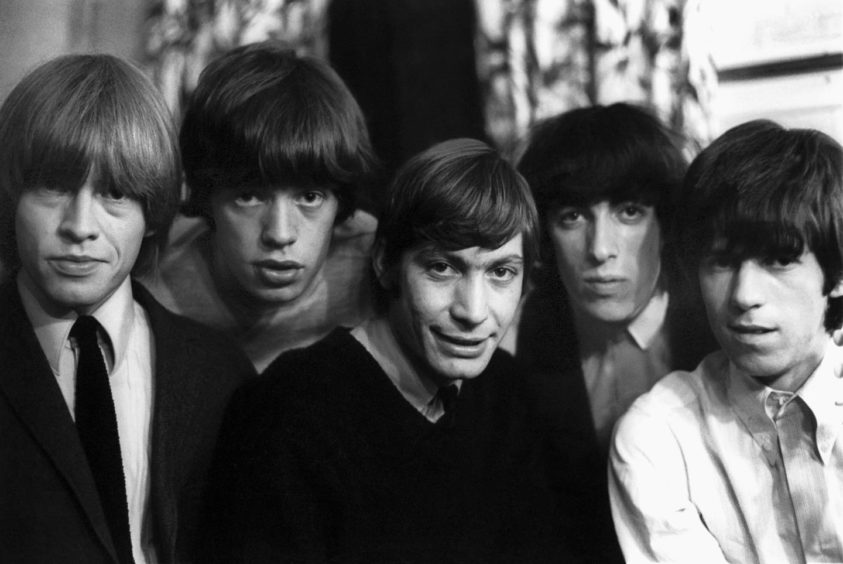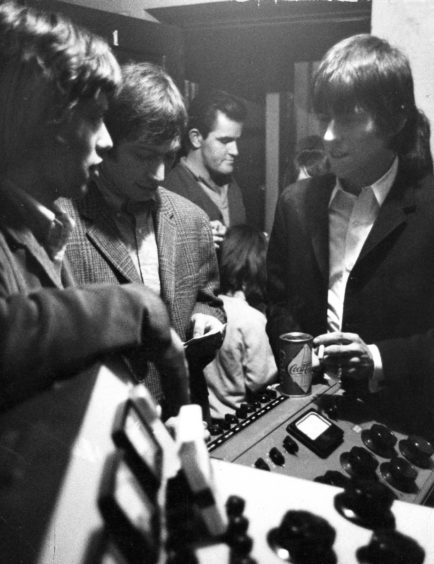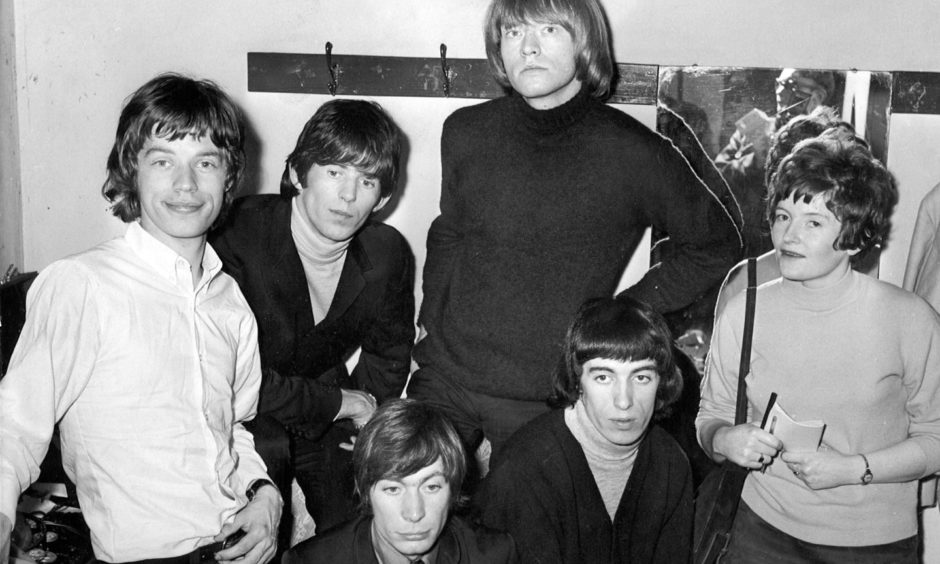The Rolling Stones performed a backstage deal to prevent a riot during a Dundee gig which signalled the changing of the guard for 60s music.
Rooster-strutting Stones frontman Mick Jagger and trouser-dropping Freddie Garrity decided on a role reversal just before the curtain went up at the Caird Hall.
Fans had now grown tired of the 1950s styles of music and the early-60s chart-toppers and there was a palpable shift from pop to rock.
The Stones played Dundee twice on May 20 1964 in a month where they crammed in an amazing 45 shows, before heading off on their first US tour.
The Stones were brought it to boost flagging ticket sales
Moray promoter Albert Bonici booked the Stones to join the bill of a pop package tour of Scotland to perform in Aberdeen, Dundee and Edinburgh.
Mr Bonici and co-promoter Andi Lothian clinched the deal after the popularity of headline act Freddie and the Dreamers started to decline in the UK.
Other artists on the bill were Peter and Gordon, Millie and the Five Embers, Dave Berry and the Cruisers, and Mark Peters and the Silhouettes.
The Stones were signed up to close the first half of the show and Freddie and the Dreamers would close the second half.
But by the time the gigs came around their cover of Buddy Holly’s Not Fade Away had peaked at number three and was still in the UK charts.
Extra police and stewards were brought in following the two shows in Aberdeen where the band was smuggled to safety to escape their screaming fans.
Mr Lothian said: “Freddie and the Dreamers were booked to top the bill, but the Rolling Stones were rushed in to booster flagging ticket sales.
“By the time the gigs came round at all three venues it was clear that the concerts were going to sell out, thanks mainly to the inclusion of the Stones.
“Freddie and the Dreamers were going out of fashion fast while the Rolling Stones’ popularity was increasing at almost the same pace as The Beatles.
“Thus the scenario was set for a series of concerts in Scotland which was to shape the moment that rock ‘n’ roll confronted its two sides.
“Which would prevail?
“The roll of Freddie or the rock of Mick?”
The Stones performed a set including Not Fade Away
The Evening Telegraph preview of the gig described the “tousled-headed” Rolling Stones as “five uncouth-looking young men”.
Tonight, the long-waiting followers of the Stones will have their wish when the group lead off the long list of well-known names on the bill of the package show.
As The Beatles are to Beethoven, so are Freddie and the Dreamers to the Rolling Stones.
This comparison all goes to prove that tonight’s show caters for a variety of tastes.”
The Stones closed the first half of the 6.30pm show with a set including Not Fade Away, Poison Ivy, Walking The Dog, Cops And Robbers and Roll Over Beethoven.
Freddie and the Dreamers closed the second half before the Stones returned to the stage to take a bow just as the curtains came down.
Mr Lothian said: “As expected, the first house was a slightly younger crowd, but the moment the Stones went on stage to close the first half the place went wild.
“Worse, after a short break, as MC, my announcement in welcoming Freddie and the Dreamers to the stage was greeted with very little enthusiasm.
“All we heard was recurring calls for ‘We want the Stones’ and ‘Mick! Mick!’
“This was of course very unbefitting and discourteous to Freddie and the band to state the obvious, but worse was to come.
“A highlight of Freddie Garrity’s act was to step out of his trousers to reveal an oversize pair of bloomers during his last number which was Short Shorts.
“Poor Freddie – what was a fine show just a few months earlier was now being viewed by many at that early house as a form of 50s music hall entertainment masquerading as popular music.
“It had been, but was obviously no longer relevant.
“At the start of the 8.50 house it was clear that Albert and I were in difficulty.
“All the talk of the incoming audience was that of Mick Jagger and the Stones.
“There was no mention of the ‘stars’ of the show, Freddie and the Dreamers.
“What could be done to avert a billing calamity with this older, more vocal crowd of Stones fans?
“They were definitely not going to settle for seeing their idols come on first while knowing they were still in the building while Freddie was on stage.”
The two acts decided to swap roles to save the Caird Hall!
The two managers were arguing their respective positions backstage.
“Freddie and the Dreamers were closing the show at all costs,” said Mr Lothian.
“Albert even produced our contracted evidence to show that we were legally bound to have Freddie close the show, while the Stones manager argued the logic and benefits to both parties of the Stones closing the show.
“Fearing that we might become embroiled in a dispute not of our making, but knowing with certainty what outcome we preferred, Albert and I retired to await a decision.
“Relief and pleasure awaited us when the band’s decided to swap roles.
“Both Albert and my reputations, and potential damage to the Caird Hall was avoided!
“Freddie and the Dreamers played a well-received first half, with the extremely content audience now engaged in the moment and singing along to the band’s hits.
“When Freddie revealed his bloomers at their final number, there was much fun and laughter, with the audience this time applauding them off the stage.
“But at just that moment in time, in Dundee on May 20 1964, heavy rock, in the shape of the Rolling Stones, came onstage to signal the end of six years of a once-extremely popular rock ‘n’ roll, in favour of the new breed of rock, which was about to shape the world’s future music scene.”
The Stones would return to the Caird Hall in 1965
Dozens of girls were carried out after fainting when the Stones returned to the stage.
The Evening Telegraph review said: “The Rolling Stones, looking slightly more respectable than I’ve seen them, gave the female members of the audience an attack of hysteria!
“The reception did not fluster the boys and they carried on without as much as a move of a muscle on their dead-pan faces.”
The fans lined the pavements outside the Royal Hotel following the gig chanting: “We want the Stones! We want the Stones!”
They watched and waited for the slightest hint of their idols at the windows of the hotel.
The Stones would go on to top the charts for the first time in July 1964 with It’s All Over Now which also became a big hit in Europe.
The band returned to Dundee and performed two shows at the Caird Hall in June 1965.
Before the gig they were taken to Broughty Ferry Rock Garden for a photo shoot for teen girl magazines Romeo and Jackie.
It was the calm before the storm as ambulance men described the scenes at the Caird Hall as “worse than the Tommy Steele riots” in April 1958.
There were 1,500 at the first house when the Rolling Stones performed where the fans managed to generate enough excitement to give the stewards and ambulance staff good practice for the battle which was to come.
Only four girls had to be removed in the first house.
At the second, with about 2,000 fans crammed in, the Marryat Hall next door, was turned into a casualty station after 40 screaming and sobbing girls were treated by ambulance crews after becoming hysterical and fainting.
One fan succeeded in breaking the cordon of 50 stewards – who were mostly ex-wrestlers – and ran on to the stage, where she hugged and kissed Jagger.













